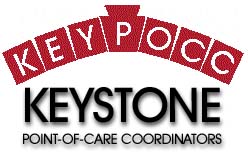

|
Contact List
Meeting Reports September 26, 2001 December 12, 2001 |
When: Wednesday, June 28, 2000 The June 28th, 2000 KEYPOCC meeting was held at Hershey Medical Center and was hosted by Dawn Earnest and Jennifer Barkman of Pinnacle Health. The guest speaker was Rodney Stewart MT (ASCP) from the College of American Pathologists. Lunch was provided by Abbott and a brief presentation was given by Leslie Pratt, Account Representative for Abbott. The morning began with a fun ice breaker game organized by Jennifer Barkman designed to have everyone meet new people and to get to know previous acquaintances a little bit better. The meeting then progressed to the topic of the day - CAP regulations presented by Rodney Stewart, Inspection Specialist. Rodney began with an overview of what constitutes point of care testing and proceeded into what we need to expect when preparing for an inspection. There were quit a few topics that generated numerous questions from the members of KEYPOCC. Listed are these "hot topics." 1) Differentiating between linearity and calibration verification. Although these terms are often used interchangeably, they are two different subjects. Calibration verification is used to verify the reportable range. You are taking specimens with known values, running the specimens and determining if the results are within the allowable limits set by the manufacturer of the specimens. You must be sure to have a min, mid, and max specimen. When doing a linearity study you can take any elevated specimen and make dilutions of that specimen. You then run the specimen and the dilutions and determine if there is a linear relationship. This is not the same as calibration verification since the analyte concentration is unknown. Many of the kits that we use for calibration verification or also linearity kits. Calibration verification is required every 6 months on all instruments. 2) To the delight of many in the room, CAP is dropping weekly review of QC!!! 3) Electronic Simulators (EQC) can be used in lieu of liquid controls for waived or moderately complex analyzers. The frequency of liquid controls must, at a minimum, meet the manufacturer's requirements. Coordinators should use caution with these guidelines because the State has different requirements. 4) The following is a list of what we should look for when conducting an inspection at another institution:
5) Frequently seen Deficiencies were as follows:
6) Are multiple instruments that perform the same assay checked at least twice a year for calibration agreement and correlation of patient results?
If you have any questions regarding CAP requirements, you can call the CAP Technical Support Line at 1-800-323-4040 ext. 6065. Our speaker Rodney Stewart can be reached at ext. 7192. You can also email your questions to CAP at accred@cap.org. Following Rodney's presentation
we had a delicious lunch provided by Abbott. After lunch Leslie
Pratt from Abbott gave a brief presentation on the i-STAT. Abbott
has broadened the test cartridge menu of the i-STAT to include
ACT levels. Future plans for the i-STAT include PT and PTT levels.
Please contact your Abbott rep for additional information or
contact Leslie at 1-800-243-1202 mailbox 535-7315. After Leslie's presentation Rodney entertained more questions regarding the CAP checklist. Following the brief question and answer session Peter Garown announced that the "demerger" of Hershey and Geisinger would take place on June 30th, 2000. So stated, it was announced that our next meeting will be at Hershey Medical Center on September 27th. The guest speaker will be Marianne Porter who will give a presentation on the POC regulations for the state of PA. Vendor participation will be from HemoCue who is also trying to find a speaker for us. Additional meeting topics are always welcome and can be posted at KEYPOCC's website. The consensus from those at the meeting was that everyone felt that the meeting went very well and was very informative. All are looking forward to the next meeting!!! Respectfully submitted |